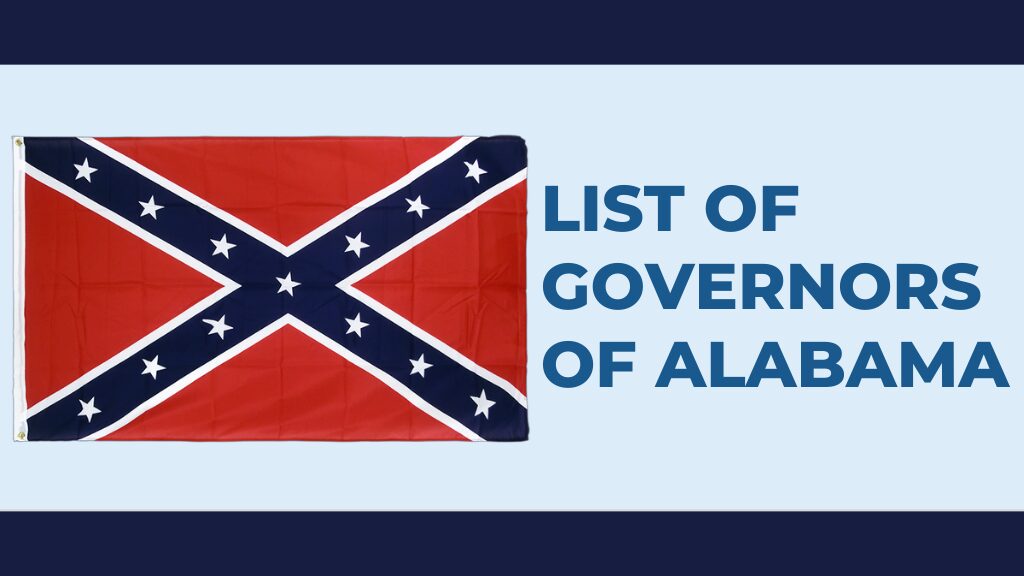Alabama, a state rich in history and culture, has been shaped by a succession of governors who have led the way through various challenges and triumphs. In this blog post, we’ll take a journey through time, exploring the list of governors of Alabama who have left an indelible mark on the Heart of Dixie.
Table of Contents
ToggleList of Governors of Alabama

Here is the List of Governors of Alabama:
- William Wyatt Bibb
- Thomas Bibb
- William R. King
- John Gayle
- Clement Comer Clay
- Hugh McVay
- Arthur P. Bagby
- Benjamin Fitzpatrick
- Reuben Chapman
- Andrew B. Moore
- John A. Winston
- Lewis E. Parsons
- Robert M. Patton
- Andrew Johnson
- John Gill Shorter
- Thomas H. Watts
- William Hugh Smith
- David P. Lewis
- Robert B. Lindsay
- Lewis E. Parsons (2nd term)
- William Hugh Smith (2nd term)
- George S. Houston
- Robert M. Patton (2nd term)
- Lewis E. Parsons (3rd term)
- Robert B. Lindsay (2nd term)
- David P. Lewis (2nd term)
- Robert M. Patton (3rd term)
- William Hugh Smith (3rd term)
- Edward A. O’Neal
- Rufus W. Cobb
- Thomas G. Jones
- William D. Jelks
- William J. Samford
- Emmet O’Neal
- Braxton Bragg Comer
- Thomas E. Kilby
- Kilby’s Successor (Bibb Graves)
- Bibb Graves
- Frank M. Dixon
- Chauncey Sparks
- Jim Folsom
- Gordon Persons
- John Patterson
- George Wallace
- Lurleen Wallace
- Albert Brewer
- George Wallace (2nd term)
- Fob James
- George Wallace (3rd term)
- Guy Hunt
- Jim Folsom Jr.
- Fob James (2nd term)
- Don Siegelman
- Bob Riley
- Robert Bentley
- Kay Ivey
Let’s delve into more details about each of the first five governors of Alabama:

William Wyatt Bibb (1819-1820):
A native of Virginia, Bibb was not only Alabama’s first governor but also one of the framers of the state constitution. A physician by profession, he brought a sense of stability to the newly established state government. Tragically, his term was cut short when he succumbed to injuries sustained in a horse-riding accident.
Thomas Bibb (1820-1821):
Brother to William Wyatt Bibb, Thomas assumed the governorship after his brother’s untimely death. Before becoming governor, he had a distinguished military career. His term continued the work of establishing essential state institutions and policies.
William R. King (1821-1825):
Born in North Carolina, King was a lawyer and a skilled orator. He served as the third governor of Alabama, focusing on economic development and infrastructure projects. King’s political career extended beyond Alabama, ultimately becoming the Vice President of the United States under President Franklin Pierce.
John Gayle (1831-1835):
A Georgia native, Gayle served as the fourth governor during a period marked by economic challenges and debates over states’ rights. His administration grappled with issues related to the nullification crisis, reflecting the broader tensions of the era.
Clement Comer Clay (1835-1837):
Born in Georgia, Clay was a lawyer who took office as Alabama’s fifth governor. His term emphasized internal improvements, including the construction of roads and canals. Additionally, he advocated for advancements in education, leaving a lasting impact on the state’s infrastructure.
Hugh McVay (1837-1838):
Hugh McVay, an Alabama native, served as the sixth governor for a brief period. Little is known about his term, as he held office during a time of economic difficulties. Despite the challenges, he contributed to the state’s governance during a critical juncture.
Arthur P. Bagby (1837-1841):
A prominent figure in Alabama politics, Bagby served two non-consecutive terms as the seventh governor. A veteran of the War of 1812, Bagby was known for his involvement in Democratic politics.
Benjamin Fitzpatrick (1841-1845):
Fitzpatrick, Alabama’s eighth governor, played a significant role not only in state politics but also at the national level. After his gubernatorial term, he became a U.S. Senator and was involved in the Compromise of 1850. Fitzpatrick’s political career spanned both state and federal arenas.
Reuben Chapman (1847-1849):
A lawyer by profession, Chapman served as the ninth governor of Alabama. His term focused on education and internal improvements. Chapman advocated for public education and worked to address issues related to the state’s infrastructure, contributing to Alabama’s development during this period.
Andrew B. Moore (1857-1861):
As the tenth governor, Andrew B. Moore faced the challenges of the pre-Civil War era. His tenure included Alabama’s secession from the Union in 1861. Moore played a crucial role in shaping the state’s response to the sectional tensions that ultimately led to the American Civil War.
John A. Winston (1853-1857):
Winston, a prominent lawyer, served as the eleventh governor of Alabama. His term witnessed the intensification of debates over states’ rights and the impending threat of the Civil War. A staunch advocate for the Southern cause, Winston’s leadership was marked by efforts to strengthen Alabama’s position in the face of growing tensions.
Lewis E. Parsons (1855-1857, 1859-1863):
Parsons, a lawyer and politician, served two non-consecutive terms as the twelfth governor. His first term coincided with the latter part of John A. Winston’s term, and he returned during the critical years of the Civil War.
Robert M. Patton (1865):
Patton, the thirteenth governor, assumed office during the tumultuous period of Reconstruction. His brief term involved navigating the complexities of rebuilding Alabama in the aftermath of the Civil War. Patton grappled with the political and social changes brought about by Reconstruction policies.
Andrew Johnson (1865-1866):
Although better known as the 17th President of the United States, Johnson also played a role in Alabama’s post-war governance. As the military governor, he worked to implement President Lincoln’s lenient approach towards the Southern states, aiming to reintegrate them into the Union.
John Gill Shorter (1861-1863):
Shorter, a lawyer and judge, served as the fourteenth governor during the critical early years of the Civil War. His term was dominated by Alabama’s secession and active involvement in the Confederate cause. Shorter faced the immense challenges of wartime governance, including resource shortages, military demands, and the impact of the Union blockade.
Thomas H. Watts (1863-1865):
A skilled attorney and Confederate veteran, Watts assumed the governorship during the latter part of the Civil War. Watts faced immense challenges as the Confederacy was in decline. His leadership focused on managing resources, and coordinating with the Confederate government.
William Hugh Smith (1865):
Smith took office during the early days of Reconstruction, a period marked by social and economic upheaval. As the sixteenth governor, Smith grappled with the complexities of transitioning Alabama from a Confederate state to a part of the Union.
David P. Lewis (1872-1874):
Lewis, a former Confederate officer, served as the eighteenth governor during the turbulent post-Reconstruction era. His term focused on economic recovery, rebuilding the state’s infrastructure, and addressing issues arising from the aftermath of the war.
Robert B. Lindsay (1870-1872):
A lawyer and judge, Lindsay assumed the governorship during a crucial period of Southern Reconstruction. His term involved efforts to adapt to the changes imposed by Reconstruction policies, promoting unity, and facilitating the reintegration of Alabama into the Union.
Lewis E. Parsons (1874-1878):
Parsons returned for a second term during the post-Reconstruction era, bringing experience and continuity to Alabama’s governance. His leadership aimed at stabilizing the state, fostering economic recovery, and addressing the ongoing impact of the Civil War. Parsons sought to navigate Alabama through a period of reconstruction and reconciliation.
William Hugh Smith (1868-1870):
Smith returned for a second term during the post-Reconstruction era. His leadership aimed at further stabilizing Alabama, fostering economic recovery, and addressing the challenges of the transitioning state. Smith’s second term focused on rebuilding infrastructure and facilitating societal reconciliation.
George S. Houston (1874-1878):
Houston, a lawyer and judge, served as the twentieth governor during a period of post-Reconstruction. His term involved efforts to heal the wounds of the Civil War and Reconstruction. Houston focused on promoting economic growth, and educational development, and navigating Alabama through the complexities of the evolving political landscape.
Robert M. Patton (1882-1885):
Returning for a second term, Patton served as the twenty-first governor. His leadership aimed at addressing the issues arising from the post-Reconstruction era, focusing on economic development and infrastructure improvements. Patton sought to guide Alabama through a period of rebuilding and progress.
Lewis E. Parsons (1885-1887):
Parsons, returning for a third term, played a pivotal role in the ongoing efforts to stabilize Alabama. His leadership focused on economic recovery and addressing the enduring impact of the Civil War. Parsons aimed to provide continuity and stability during a time of transition.
Robert B. Lindsay (1889-1890):
Lindsay returned for a second term as the twenty-third governor. His leadership during this period involved addressing economic challenges and fostering development. Lindsay’s second term reflected the ongoing efforts to shape Alabama’s trajectory during a time of change.
David P. Lewis (1887-1890):
Lewis, in his second term, contributed to the ongoing development of Alabama during a critical phase of its post-Reconstruction era. His leadership focused on economic progress, infrastructure development, and addressing the social and political issues facing the state.
Robert M. Patton (1899-1900):
Patton, in his third term, served as the twenty-ninth governor. His leadership aimed at navigating Alabama through the complexities of the turn of the century, focusing on economic development, education, and addressing emerging challenges in the state.
William Hugh Smith (1900-1903):
Returning for a third term, Smith served as the thirtieth governor. His leadership during this period involved addressing issues related to industrialization, economic progress, and continued efforts to shape Alabama’s future.
Edward A. O’Neal (1882-1885):
O’Neal served as the twenty-second governor. His leadership during this period focused on issues related to agricultural development, economic progress, and education. O’Neal contributed to shaping Alabama’s policies during a time of economic transition.
Rufus W. Cobb (1878-1882):
Cobb, a physician and politician, served as the twenty-fourth governor. His term involved efforts to stabilize the state’s economy, promote industrial development, and address the challenges arising from the post-Reconstruction era.
Thomas G. Jones (1890-1894):
Jones served as the twenty-fifth governor. His term involved addressing economic challenges, promoting industrial development, and contributing to the state’s educational progress. Jones played a role in shaping Alabama’s policies during a period of transition.
William D. Jelks (1901-1907):
Jelks, a lawyer and politician, served as the twenty-sixth governor. His leadership focused on economic development, education, and social progress. Jelks played a role in guiding Alabama through the complexities of the early 20th century.
William J. Samford (1901-1907):
Samford, a lawyer and judge, served as the twenty-seventh governor. His term involved efforts to address economic challenges, promote infrastructure development, and contribute to the state’s progress. Samford played a crucial role in shaping Alabama’s policies during his tenure.
Emmet O’Neal (1911-1915):
O’Neal served as the twenty-eighth governor. His leadership during this period focused on economic progress, educational advancements, and addressing issues related to social welfare. O’Neal contributed to shaping Alabama’s policies during a dynamic period.
Braxton Bragg Comer (1907-1911):
Comer, a businessman and politician, served as the twenty-ninth governor. His term involved efforts to address economic challenges, promote agricultural development, and contribute to the state’s industrial growth.
Thomas E. Kilby (1919-1923):
Kilby, a businessman, served as the thirtieth governor. His leadership focused on economic recovery after World War I, promoting infrastructure development, and addressing social issues. Kilby played a role in guiding Alabama through a period of post-war adjustments.
Kilby’s Successor (Bibb Graves) (1923-1927):
Bibb Graves succeeded Kilby as the thirty-first governor. Graves, a farmer and politician, focused on continuing Kilby’s policies, including economic development and education. Graves played a role in shaping Alabama’s trajectory during the 1920s.
Bibb Graves (1927-1931):
Graves served as the thirty-second governor during a period marked by economic challenges, including the Great Depression. His leadership involved efforts to address economic difficulties, promote social programs, and contribute to the state’s recovery.
Frank M. Dixon (1939-1943):
Dixon, a lawyer and politician, served as the thirty-fourth governor during the early years of World War II. His term involved navigating the challenges of wartime, contributing to the war effort, and addressing economic and social issues.
Chauncey Sparks (1943-1947):
Sparks, a businessman, served as the thirty-fifth governor during the later years of World War II. His leadership involved addressing the challenges of wartime and contributing to the state’s post-war recovery. Sparks played a role in shaping Alabama’s policies during a dynamic period.
Jim Folsom (1947-1951, 1955-1959):
Folsom, known as “Big Jim,” served two non-consecutive terms as the forty-fifth and forty-seventh governor. His terms were marked by progressive policies, including advancements in education and infrastructure, making him a popular figure in Alabama politics.
Gordon Persons (1951-1955):
Persons, a businessman, served as the forty-sixth governor. His term involved continuing some of Folsom’s progressive policies and focusing on economic development. Persons played a role in shaping Alabama’s policies during the mid-20th century.
John Patterson (1959-1963):
Patterson, a lawyer, served as the forty-eighth governor. His term was marked by efforts to maintain segregation, and he was known for his stance during the Civil Rights Movement. Patterson played a significant role in the political landscape of the early 1960s.
George Wallace (1963-1967, 1971-1979, 1983-1987):
Wallace, a powerful and controversial figure, served four non-consecutive terms as the forty-ninth, fifty-third, fifty-fifth, and fifty-seventh governor. His first term is infamous for his stand against desegregation at the University of Alabama.
Lurleen Wallace (1967-1968):
Lurleen, the wife of George Wallace, served as the fiftieth governor. Her term was historic as the first woman governor of Alabama. Lurleen served for a brief period, as her tenure was cut short by illness, leading to her passing in office.
Albert Brewer (1968-1971):
Brewer, a lawyer and politician, served as the fifty-first governor. His term focused on advancing education and infrastructure development. Brewer played a role in shaping Alabama’s policies during a transitional period.
George Wallace (1971-1979):
Returning for a second term, Wallace continued to be a dominant force in Alabama politics. His later terms involved more moderate policies, and he emphasized economic development and industrialization.
Fob James (1979-1983):
James, a businessman and former football coach, served as the fifty-sixth governor. His term involved addressing economic challenges and fostering industrial growth. James played a role in shaping Alabama’s policies during the late 20th century.
George Wallace (1983-1987):
Returning for a third term, Wallace continued to be a central figure in Alabama politics. His later terms focused on issues of economic development, education, and state governance.
Guy Hunt (1987-1993):
Hunt, a farmer and minister, served as the fifty-eighth governor. His term focused on agriculture, economic development, and rural issues. Hunt was the first Republican governor of Alabama since Reconstruction.
Jim Folsom Jr. (1993-1995):
The son of Jim Folsom, Folsom Jr. served as the fifty-ninth governor. His term involved addressing economic challenges and continuing some of the progressive policies associated with his father.
Fob James (1995-1999):
Returning for a second term, James continued his focus on economic development and education. His policies aimed to address issues facing Alabama during the late 20th century.
Don Siegelman (1999-2003):
Siegelman, a lawyer and politician, served as the sixtieth governor. His term involved efforts to improve education, expand healthcare, and address economic issues. Siegelman played a role in shaping Alabama’s policies during the turn of the century.
Bob Riley (2003-2011):
Riley, a businessman and politician, served as the sixty-first governor. His term involved addressing economic challenges, ethics reform, and advancing education initiatives. Riley played a role in shaping Alabama’s policies during the early 21st century.
Robert Bentley (2011-2017):
Bentley, a physician, served as the sixty-second governor. His term involved issues related to healthcare, economic development, and ethics reform. Bentley faced challenges during his tenure, including controversies that led to his resignation.
Kay Ivey (2017-present):
Ivey, a politician and former Lieutenant Governor, currently serves as the sixty-third governor. Her leadership has focused on economic development, infrastructure improvement, and addressing issues facing Alabama in the present day.
Conclusion
Alabama’s governors have played a pivotal role in shaping the state’s past, present, and future. Their decisions and leadership styles have left lasting impressions on the people and the landscape. As we look ahead, it’s crucial to reflect on the lessons learned from history to pave the way for a better tomorrow. Explore more on copypastequickly.
FAQs
How long can a governor serve in Alabama?
Governors in Alabama can serve a maximum of two consecutive terms.
Who was the first female governor of Alabama?
Lurleen Wallace holds the distinction of being Alabama’s first female governor.
How often are gubernatorial elections held in Alabama?
Gubernatorial elections in Alabama are held every four years.
Related Post:





